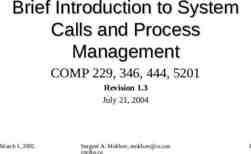An Overview: Economic Relations Division
22 Slides1.09 MB

An Overview: Economic Relations Division

Vision, Mission and Mandate Vision Sustainable socio-economic development. Mission Management of foreign assistance and support implementation of the national development strategies through strengthening relationships with development partners . Mandate Formulation of overall future external borrowing strategy; Assessment, negotiation, mobilization and allocation of foreign assistance; External debt management, including debt profiling and budgeting, debt servicing; and Strengthen economic cooperation

Organization ERD Wing 1 JAPAN, USA, CANADA Wing 2 WORLD BANK Wing 3 ADMINISTRATION AND MIDDLE EAST Wing 4 UN ORGANIZATION Wing 5 ADB Wing 6 COORDINATION, IFAD & NORDIC Wing 7 EUROPE Wing 8 ASIA AND AIIB Wing 9 AID AND DEDT MANAGEMENT Wing 10 DEVELOPMENT EFFECTIVENESS

Current Personnel Status Category Sanctioned Posts Currently Working Vacant Posts 1st Class 119 102 17 2nd Class 114 101 13 3rd Class 97 71 26 4th Class 111 90 21 Total 441 364 77

Major Milestones Resource Mobilization LDC Graduation BDF Mobilized 17.9 and 14.9 billion in FY 2017 and 2018 Succeeded in getting the 1st recommendation of UN-CDP Organized in 2018 for strengthening GoB-DP coordination E-FILING Continues to be champion among all Ministries and Division APA Capacity Development NIS Scored 94.4% marks and ranked as one of the top 5 Ministries and Divisions in FY 2018 Trained 100 govt. officials on International development Cooperation (on-going) Implementing all the targets/activities in time and efficiently

External Resource: Mobilization Achieved commitments of more than USD 10 billion in last two FYs consecutively. In FY 2018 disbursement scored highest since independence During the last 5 FYs USD 50.7 billion has been committed which is 1.3 times higher than that of previous 5 FYs

External Resource: Disbursement Recorded the highest disbursement (USD 6.36 billion) in FY 2018 since independence From FY 2014 to FY 2018 yearly average disbursement is USD 3.9 billion which was USD 2.2 billon from FY 2009 to FY 2013

External Resource: Annual Development Program (ADP) In absolute term contribution of PA to ADP has been increasing over the years Contribution of PA increased by 3 times within 5 years period

External Debt: Servicings

External Debt: Compositions DP France/AFD Japan Russia South Korea Denmark Germany/KFW Kuwait/KADFD Saudi Arabia/SFD U.A.E. China India Debt Outstanding as on 30th June 2018 94.80 4,705.12 1,205.92 430.92 59.04 7.43 145.93 100.52 46.21 1997.40 324.09 I n M i l l i o n U S D DP A.D.B. I.D.A. I.D.B. I.F.A.D. O.P.E.C. EIB AIIB Debt Outstanding as on 30th June 2018 8847.73 14209.09 521.62 454.34 111.58 50.90 94.20 Total: 33,613 Million USD

External Debt: Compositions 0.8% 14.0% 19.0% SDR 2.7% 2.8% USD JPY 60.7% EURO RMB Other

External Debt Sustainability: Public Sector Indicators FY FY 2018 2017 Solvency Position FY 2016 Threshol d Level Debt To GDP 14.3% 12.8% 13.2% 40% Debt To Export plus Remittance 70.3% 63.6% 56.3% 150% Liquidity Position Debt Service to Export plus Remittance 3.5% 4.0% 4,6% 20% Debt service to Revenue 6.9% 7.9% 10.8% 30%

Impacts of LDC Graduation and LMIC status on the foreign assistance – The LDC graduation has almost no impact on the foreign assistance flows rather enhanced creditworthiness due to graduation might increase the flow; – In the post- LMIC period external resources flows may also increase with greater access to various financing windows of DPs; – Graduation as LMIC may increase cost of borrowing; but it will still be lesser than the domestic loans.

External Debt: Changing Terms and Condition in the post LMIC Status DP Pre-LMIC Status Post -LMIC World Bank Maturity: 38-40 Years, Grace Period:10-6 years Interest rate: 0.75% Options: Currency or interest base fixed 1,205.924 Maturity: 30 Years, Grace Period:5 years Interest rate: /-2% Options: Currency or interest base open to choose Japan Maturity: 40 Years, Grace Period:10 years, Interest rate: 0.01% Options: Currency or interest base fixed Maturity: 30 Years, Grace Period:10 years, Interest rate: 0.92% Options: Currency or interest base open to choose ADB Maturity: 25 Years, Grace Period: 5 years, Interest rate: 2% or LIBOR based Options: Currency or interest base fixed Maturity: 25 Years, Grace Period: 5 years, Interest rate: 2% or LIBOR based Options: Currency or interest base fixed

New Features in Development Cooperation: UN The Green Climate Fund (GCF) Established in 2010 to support the efforts of developing countries to respond to the challenge of climate change. ERD has been assigned to act as National Designated Authority (NDA) Key Role of NDA Playing role as NDA from November, 2014 Selected Two Direct Accredited Entities ( PKSF, IDCOL) 6 International Accredited Entities (IAE) UNDP, KfW, GIZ, IFC, IUCN, WB Approved 3 projects amounting to 85.42 million US 4 Projects are awaiting for GCF Board Approval Involving in the Formulation of National Adaptation Plan

New Features in Development Cooperation South-South Cooperation Non-Residence Bangladeshi (NRB) A platform of exchanging knowledge, expertise and best practices among Countries of the global South ERD has established a cell for managing the issue Achievements: –Publication of South-South Cooperation for Financing SDGs. –5 best practices of Bangladesh included in the UN Global Publication Vol. II –Participated in Global South-South Development Expo (GSSD) in Turkey in 2017 and New York in 2018. Upcoming issue: Buenos Aires Plan of Action (BAPA) 40 Conference on South-South Cooperation to be held in 20-22 March, 2019. An approach to engage NRBs in Bangladesh national development initiative Areas of Engagement : – Philanthropy – Investment and – Expert affiliation of national development. A website (www.nrb.gov.bd) has been developed to connect NRBs A task force has been working under the guidance of Principal Secretary, Principal Coordinator, Secretary ERD. Working on formulating Standard Operational Procedure (SOP) An International Workshop and two Regional Workshops will be held in Dhaka, Sylhet and Chattogram respectively.

New Features in Development Cooperation Global Partnership for Effective Development Cooperation (GPEDC) a. b. c. d. GPEDC established in 2011 to bring together development actors around a set of four internationally-agreed principles : ownership by developing countries, a focus on results, inclusive partnerships and transparency and accountability between development partners. Core functions of GPEDC Supporting effectiveness at the country level Generating evidence for accountability and SDG follow-up Sharing knowledge and lessons Building political momentum for effective development co-operation Bangladesh is currently the Co-Chair of GPEDC and Committed to implement the development effectiveness principles at the country level LDC Graduation In March 2018 Bangladesh for the first time met all the criteria to graduate from the LDCs status, namely GNI per Capita, Human Asset Index, and Economic Vulnerability If Bangladesh meets the criteria for a second time in 2021, it may be recommended for graduation – potentially in 2024 Bangladesh has already started preparing its transition out of the LDC category and closely working with UN and other international entities Bangladesh Development Forum (BDF) Bangladesh Development Forum (BDF) The The objective objective of of the the BDF BDF is is to to effectively effectively address economic, social, and address economic, social, and environmental environmental determinants determinants combining combining multi-stakeholder multi-stakeholder and and multi-sectoral multi-sectoral action action across across government government and and society society on on some priority areas some priority areas BDF BDF serves serves as as an an important important platform platform for for dialogue on ways to accelerate dialogue on ways to accelerate Bangladesh’s Bangladesh’s development, development, to to prepare prepare for a changed future role of for a changed future role of development development partners, partners, aa growing growing role role for for the private sector, CSOs, and NGOs the private sector, CSOs, and NGOs BDF BDF 2018, 2018, held held in in January January 17-18, 17-18, explored the Government’s explored the Government’s progress progress against against its its own own development development goals goals as as set set out in the 7FYPand in line with the SDGs out in the 7FYPand in line with the SDGs

Leaderships in National and International Forums Hon’ble Finance Minister (HFM) acts as Governor in ADB, WB, IsDB, AIIB etc HFM is the Co-Chair of Global Partnership for Effective Development Cooperation (GPEDC) with Germany and Uganda Bangladesh is the Chair of AP-DEF and Vice Chair of IATI ERD Secretary is the Chair of Local Consultative Group (LCG) Plenary

External Resource Mobilization in the changing scenario Strength Weakness Opportunity Threat Macro-economic Stability Concentrating in growth driving sectors: infrastructure, social sector Comfortable debt sustainability position Time and Cost overrun due to slow Project implementation and disbursement Governance Capacity of the officials Changing economic Power Structure and emergence of new financer GCF for mitigating risk of climate change South-South Cooperation Limited concessional external resources Decreasing trend of Grant aid Increasing trends of borrowing cost Refugee Crisis and Redirection of aid to domestic refugees expenses.

Strategic Guidance for Future Activities Continuing Prudent External Borrowing strategy with a view to maximizing grant and concessional loans as long as we have the access. Continued focus on mobilizing external resources for implementing SDGs and national plan. Continued priority to mobilize finance for infrastructure related projects. Limited non-concessional loans are being mobilized for infrastructure projects which have a high Rate of Returns including power. Continued efforts to ensure just share from Green Climate Fund (GCF) for mitigating risks of Climate Change. The procedures need to be simplified Oversight mechanism will be strengthened

Strategic Guidance for Future Activities (Contd.) Developing and implementing appropriate LDC Graduation Strategy and thus complementing SDGs implementation (a project is being implemented towards this end) Ensuring effective utilization of resources by country level implementation of development effectiveness principles Strengthening database on foreign aid (AIMS and FAMS) for ensuring accountability and transparency of foreign aid Developing national policy on Development Cooperation for better management of assistance. Ensuring effective leadership in national and international forums to uphold the nation’s interests Engaging all stakeholders and strengthening coordination for effective development cooperation

Thank You






